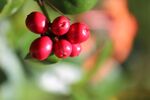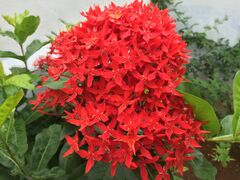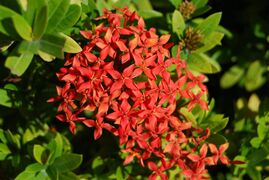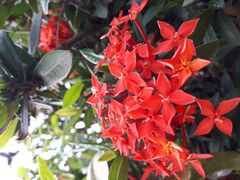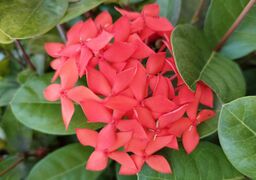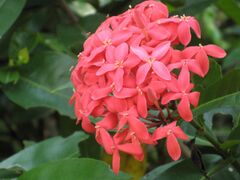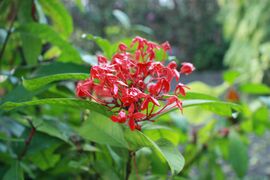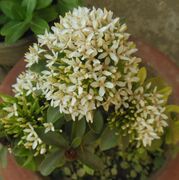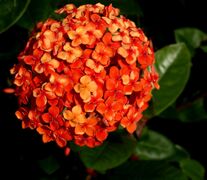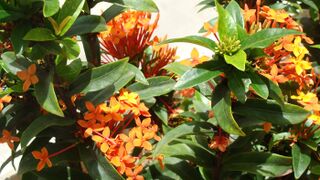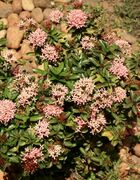Biology:Ixora coccinea
| Ixora coccinea | |
|---|---|
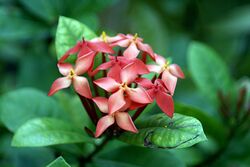
| |
| Ixora coccinea in Kerala, India | |
| Scientific classification | |
| Kingdom: | Plantae |
| Clade: | Tracheophytes |
| Clade: | Angiosperms |
| Clade: | Eudicots |
| Clade: | Asterids |
| Order: | Gentianales |
| Family: | Rubiaceae |
| Genus: | Ixora |
| Species: | I. coccinea
|
| Binomial name | |
| Ixora coccinea | |
Ixora coccinea (also known as jungle geranium, flame of the woods or jungle flame or pendkuli) is a species of flowering plant in the family Rubiaceae.[1] It is a common flowering shrub native to Southern India, Bangladesh, and Sri Lanka. It has become one of the most popular flowering shrubs in South Florida gardens and landscapes.[2][3] It is the national flower of Suriname.[citation needed] Commercially important medicinal plant, used in ayurveda. All parts including flower, leaves and root are taken for various medicinal preparations for skin disease, Diabetes etc.
Description
Ixora coccinea is a dense, multi-branched evergreen shrub, commonly 4–6 ft (1.2–1.8 m) in height, but capable of reaching up to 12 ft (3.7 m) high. It has a rounded form, with a spread that may exceed its height. The glossy, leathery, oblong leaves are about 4 in (10 cm) long, with entire margins, and are carried in opposite pairs or whorled on the stems. Small tubular, scarlet flowers in dense rounded clusters 2–5 in (5.1–12.7 cm) across are produced almost all year long.
Cultivation and use
Although there are around 500 species in the genus Ixora, only a handful are commonly cultivated, and the common name, Ixora, is usually used for I. coccinea. I. coccinea is used in warm climates for hedges and screens, foundation plantings, massed in flowering beds, or grown as a specimen shrub or small tree. In cooler climate, it is grown in a greenhouse or as a potted house plant requiring bright light. I. coccinea is also grown in containers, looking very distinguished as a patio or poolside plant. This tight, compact shrub is much branched and tolerates hard pruning, making it ideal for formal hedges, although it is at its best when not sheared.
There are numerous named cultivars differing in flower colour (yellow, pink, orange) and plant size. Several popular cultivars are dwarfs, usually staying under 3 ft (0.91 m) in height. Nora Grant is a popular dwarf and Super King is a popular hybrid with much larger flower clusters. Many new cultivars and hybrids of I. coccinea have come to market in the last couple of decades, leading to a resurgence in popularity for the beautiful flame-of-the-woods.
The flowers, leaves, roots, and the stem are used to treat various ailments in the Indian traditional system of medicine, the Ayurveda, and in various folk medicines, in traditional Indian medicine the fusion of juice leaves and the fruit of Ixora coccinea is used to care for dysentery, ulcers and gonorrhea.
Chemical constituents
Phytochemical studies indicate that the plant contains the phytochemicals lupeol, ursolic acid, oleanolic acid, sitosterol, rutin, lecocyanadin, anthocyanins, proanthocyanidins, and glycosides of kaempferol and quercetin.[4]
Taxonomy
Ixora coccinea was first described in 1753 by Carl Linnaeus in his Species Plantarum 1: 110.[5]
Ixora cultivars
References
- ↑ "Ixora coccinea catalog". Flowers of India. http://www.flowersofindia.net/catalog/slides/Ixora%20red.html.
- ↑ "Ixora coccinea Linn". Toxicology Center. Archived from the original on 5 July 2015. https://web.archive.org/web/20150705150339/http://www.toxicologycentre.com/English/plants/Botanical/techi.html.
- ↑ no_name12 (2022-02-15). "40 Florida Shrubs (Flowering, Evergreen, Vines): Pictures and Identification" (in en-US). https://leafyplace.com/florida-shrubs/.
- ↑ Baliga MS, Kurian PJ "Ixora coccinea Linn.: traditional uses, phytochemistry and pharmacology", Chin J Integr Med. 2012 Jan;18(1):72-9
- ↑ Ixora coccinea en Trópicos
External links
- Floridata - Jungle Geranium
- Florida Gardener - Jungle Geranium
- College of Micronesia - Jungle Geranium
- World Checklist of Rubiaceae
Wikidata ☰ Q1856114 entry
 |

